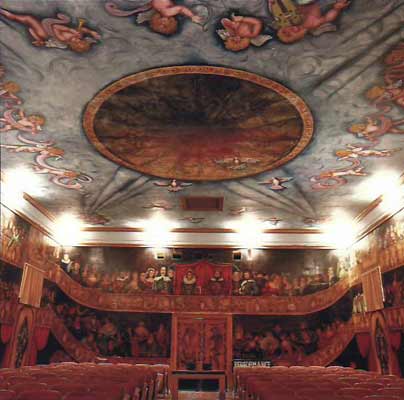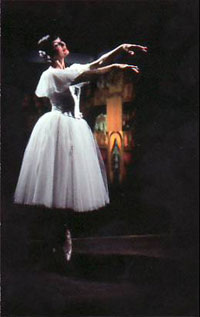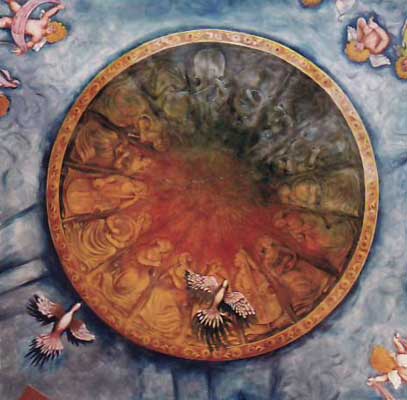Documentary Chronicles Marta Becket’s 40-Year Solo Career
Amargosa, Population One

The eastern California desert is a beautiful, desolate place-a land of sand and tumbleweed, creosote bushes, wild burros, and gusts of wind that whip clouds of dust high into the sky. It’s a landscape that brings some people to life, and speaks to others of death. It’s also a land of ghost towns. Driving through the tiny community of Death Valley Junction, 30 miles from the closest gas station, you’d be forgiven for thinking it was uninhabited. It almost is-except for one woman.
In 1967, a young dancer from New York City drove out to California for a vacation with her husband. Her name was Marta Becket. In Death Valley National Park, they got a flat tire, and were directed to Death Valley Junction to have it repaired. Wandering around town, Marta stumbled upon the Amargosa Hotel. She followed its adobe colonnade to the far end, where she was amazed to discover an abandoned theater. Peering through a hole in the wall, she was overcome with the desire to stay and fix it up.

Forty-one years later, 83-year-old Becket is the sole resident of Death Valley Junction and the director of the AmarÂ-gosa Opera House, where, since 1968, she has performed her one-woman show every week for eight months of every year. Becket’s shows incorporate dancing, singing, acting, and original music. She paints her own sets and backdrops, sews her own costumes, choreographs her own movements, and writes her own scripts.
“In the old days, after being here three or four years, I often gave a performance and nobody showed up,” Becket told me on the phone from Death Valley Junction recently. “People asked why I did it, and I said, ‘Well, I have to be ready for when they do show up.'”
Becket is the subject of a 2000 Emmy Award-winning documentary, Amargosa, directed by Todd Robinson. This Saturday, June 28, the Santa Ynez Valley Performing Arts Company (SYVPAC) hosts a screening of the film in Buellton. The proceeds will go toward the creation of a museum in Death Valley Junction that will house Becket’s costumes, dummies, and stage sets.
Christine Fossemalle is the director of SYVPAC. Originally from France, she lives in the valley, where for more than two decades she has taught ballet at the Fossemalle Dance Studio. She discovered Becket by chance when visiting Death Valley 20 years ago and has returned two to three times every year since then, often with her students. According to Fossemalle, Becket is an inspiration to anyone who wants to follow a dream.

“The goal in screening this movie is to introduce Marta and her endeavors to the larger community,” she explained. “People don’t really know about her. But when I’ve gone to see her perform, I’ve been amazed at the number of audience members who had seen the show years ago and been inspired to do whatever they desired. Five or 10 years later, they come back again to see her and to tell her what they have accomplished because of her. When you see that repeatedly, you realize that it’s not just about dance; it’s not even just about art.”
It’s certainly about perseverance. In recent years, a chronic knee injury and a fall from a ladder have made dancing difficult, so Becket has modified her performance to what she calls a “sitting-down show.” Still, Becket performs every Saturday, November through May, to a sold-out house of 114 people who come from all over the world to see her.
In her early years, when an audience was not a given, Becket decided to create a captive audience by painting the walls and ceiling of the opera house with a giant mural representing a Renaissance court. The project took her six years, during which her husband left her.
The delicate balance between the call of one’s art and the duties and expectations of relationships lies at the heart of Amargosa and is clearly a theme of Becket’s life. “My husband became very envious of my love for what I wanted to do,” she told me. “I was happy when I was dancing, or painting, or composing music, and it made him angry because I wasn’t made happy by him. But if you are a true artist, you can’t replace the time you want to spend on your creative endeavor to please someone you love. And if the person you love doesn’t love you enough to understand that, you have a decision to make: Either they change you, or you don’t change and continue on your path to your dream.”
Amargosa plays up the drama of Becket’s difficult relationship with her husband, as well as with her mother and father, emphasizing her preoccupation with animals and her fascination with ghosts-Becket mentioned in our interview that she found the film’s emphasis on the latter disappointing. But what comes through most powerfully, both in the film and in conversation with Becket, is her utter dedication to the life she has chosen.
“I don’t regret a thing,” she said. “How could I regret what I’ve done in 40 years: the murals, the ceiling, 40 stage productions, the freedom to do what I want? What would I do if I went back to New York-be a bag lady? I’ve made my world here. It seems to do something for my audiences-they come back over and over again.”
For Fossemalle, Becket provides a vision of what is possible out of total dedication to a calling. “Being in Santa Ynez and trying to teach ballet, it’s a little bit difficult, not like in a bigger city,” Fossemalle said. “So just seeing her perseverance, and seeing that when she first arrived there 40 years ago people were saying it was crazy, but that now people from all over the world who can appreciate what she is doing are showing up-that is inspiring. In my own little way, I am thinking about how I need to persevere. I feel like if I can help her, my life will be worthwhile.”
For now, Becket continues with her life’s work, creating her performances for the most part in isolation. “If you have a drive and a passion for your art, make it your life,” she advised. “You must not allow someone to come in your life and try to change you. It may be that you feel alone, but you won’t be alone, because you’ll have your talent and your art, whatever it is. In my instance, those are my best friends; they’ve never let me down, and I won’t let them down.”
There are those who predict that Death Valley Junction will become a proper ghost town after Becket’s death-it’s not easy to imagine anyone carrying on her legacy. “People ask why I don’t find someone young whom I can train to take over for me,” Becket said, “But I say, ‘For $600 a month-to create your own show, paint your own scenery, make your own costumes, write your own scenarios, and do all the paperwork-who would I get to do that?’ And then they don’t ask anymore.” Yet she hopes young artists will be encouraged by her example to take risks and to strike out on their own. “When I told people back in New York that I was going to create a one-woman show, they said, ‘What’s that? Who are you going to be with?'” she remarked. “I said, ‘I’m with myself!’ They couldn’t understand that. Now, they do.”
4•1•1
Amargosa screens at the Parks Plaza Theater in Buellton on Saturday, June 28, at 9:30 a.m. Call 688-8494 or visit amargosafilm.com. For more on Marta Becket, visit amargosaoperahouse.com.



